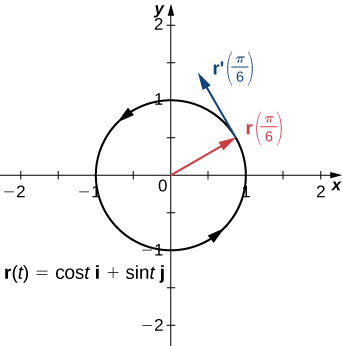
To study the calculus of vector-valued functions, we follow a similar path to the one we took in studying real-valued functions. First, we define the derivative, then we examine applications of the derivative, then we move on to defining integrals. However, we will find some interesting new ideas along the way as a result of the vector nature of these functions and the properties of space curves.
Now that we have seen what a vector-valued function is and how to take its limit, the next step is to learn how to differentiate a vector-valued function. The definition of the derivative of a vector-valued function is nearly identical to the definition of a real-valued function of one variable. However, because the range of a vector-valued function consists of vectors, the same is true for the range of the derivative of a vector-valued function.
The derivative of a vector-valued function
is
provided the limit exists. If
exists, then r is differentiable at t. If
exists for all t in an open interval
then r is differentiable over the interval
For the function to be differentiable over the closed interval
the following two limits must exist as well:
Many of the rules for calculating derivatives of real-valued functions can be applied to calculating the derivatives of vector-valued functions as well. Recall that the derivative of a real-valued function can be interpreted as the slope of a tangent line or the instantaneous rate of change of the function. The derivative of a vector-valued function can be understood to be an instantaneous rate of change as well; for example, when the function represents the position of an object at a given point in time, the derivative represents its velocity at that same point in time.
We now demonstrate taking the derivative of a vector-valued function.
Use the definition to calculate the derivative of the function
Let’s use [link]:
Notice that in the calculations in [link], we could also obtain the answer by first calculating the derivative of each component function, then putting these derivatives back into the vector-valued function. This is always true for calculating the derivative of a vector-valued function, whether it is in two or three dimensions. We state this in the following theorem. The proof of this theorem follows directly from the definitions of the limit of a vector-valued function and the derivative of a vector-valued function.
Let f, g, and h be differentiable functions of t.
then
then
Use [link] to calculate the derivative of each of the following functions.
We use [link] and what we know about differentiating functions of one variable.
is
The second component is
We have
and
so the theorem gives
and the second component is
We have
and
so we obtain
is
the second component is
and the third component is
We have
and
so the theorem gives
We can extend to vector-valued functions the properties of the derivative that we presented in the Introduction to Derivatives. In particular, the constant multiple rule, the sum and difference rules, the product rule, and the chain rule all extend to vector-valued functions. However, in the case of the product rule, there are actually three extensions: (1) for a real-valued function multiplied by a vector-valued function, (2) for the dot product of two vector-valued functions, and (3) for the cross product of two vector-valued functions.
Let r and u be differentiable vector-valued functions of t, let f be a differentiable real-valued function of t, and let c be a scalar.
The proofs of the first two properties follow directly from the definition of the derivative of a vector-valued function. The third property can be derived from the first two properties, along with the product rule from the Introduction to Derivatives. Let
Then
To prove property iv. let
and
Then
The proof of property v. is similar to that of property iv. Property vi. can be proved using the chain rule. Last, property vii. follows from property iv:
□
Now for some examples using these properties.
Given the vector-valued functions
and
calculate each of the following derivatives using the properties of the derivative of vector-valued functions.
and
Therefore, according to property iv.:
Recall that the cross product of any vector with itself is zero. Furthermore,
represents the second derivative of
Therefore,
Recall from the Introduction to Derivatives that the derivative at a point can be interpreted as the slope of the tangent line to the graph at that point. In the case of a vector-valued function, the derivative provides a tangent vector to the curve represented by the function. Consider the vector-valued function
The derivative of this function is
If we substitute the value
into both functions we get
The graph of this function appears in [link], along with the vectors
and

Notice that the vector
is tangent to the circle at the point corresponding to
This is an example of a tangent vector to the plane curve defined by
Let C be a curve defined by a vector-valued function r, and assume that
exists when
A tangent vector v at
is any vector such that, when the tail of the vector is placed at point
on the graph, vector v is tangent to curve C. Vector
is an example of a tangent vector at point
Furthermore, assume that
The principal unit tangent vector at t is defined to be
provided
The unit tangent vector is exactly what it sounds like: a unit vector that is tangent to the curve. To calculate a unit tangent vector, first find the derivative
Second, calculate the magnitude of the derivative. The third step is to divide the derivative by its magnitude.
Find the unit tangent vector for each of the following vector-valued functions:
Find the unit tangent vector for the vector-valued function
Follow the same steps as in [link].
We introduced antiderivatives of real-valued functions in Antiderivatives and definite integrals of real-valued functions in The Definite Integral. Each of these concepts can be extended to vector-valued functions. Also, just as we can calculate the derivative of a vector-valued function by differentiating the component functions separately, we can calculate the antiderivative in the same manner. Furthermore, the Fundamental Theorem of Calculus applies to vector-valued functions as well.
The antiderivative of a vector-valued function appears in applications. For example, if a vector-valued function represents the velocity of an object at time t, then its antiderivative represents position. Or, if the function represents the acceleration of the object at a given time, then the antiderivative represents its velocity.
Let f, g, and h be integrable real-valued functions over the closed interval
is
The definite integral of a vector-valued function is
is
The definite integral of the vector-valued function is
Since the indefinite integral of a vector-valued function involves indefinite integrals of the component functions, each of these component integrals contains an integration constant. They can all be different. For example, in the two-dimensional case, we can have
where F and G are antiderivatives of f and g, respectively. Then
where
Therefore, the integration constant becomes a constant vector.
Calculate each of the following integrals:
Next, substitute this back into the integral and integrate:
Calculate the following integral:
Use the definition of the definite integral of a plane curve.
is also a tangent vector to the curve. The unit tangent vector
is calculated by dividing the derivative of a vector-valued function by its magnitude.
Compute the derivatives of the vector-valued functions.
A sketch of the graph is shown here. Notice the varying periodic nature of the graph.

For the following problems, find a tangent vector at the indicated value of t.
Find the unit tangent vector for the following parameterized curves.
Two views of this curve are presented here:
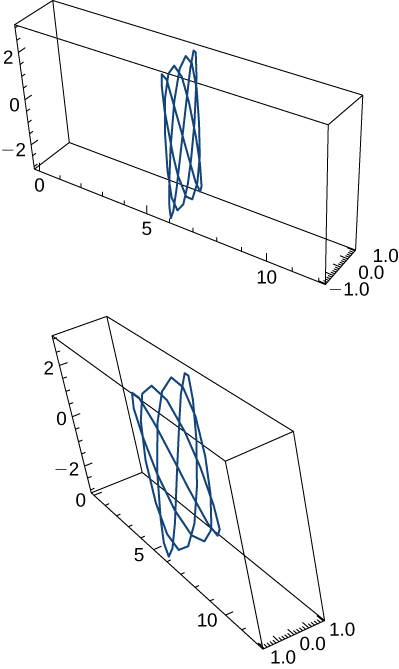
Let
and
Here is the graph of the function:
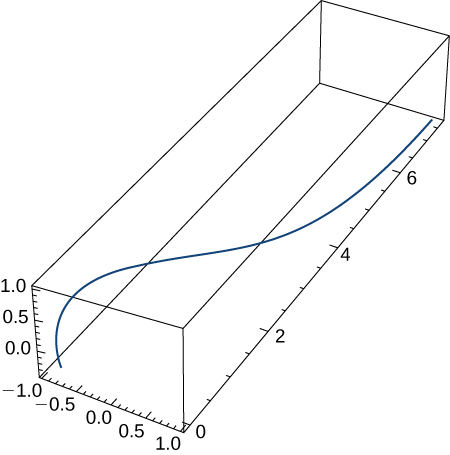 Find the following.
Find the following.
Compute the first, second, and third derivatives of
Find
The acceleration function, initial velocity, and initial position of a particle are* * *
Find
The position vector of a particle is
(if it exists).
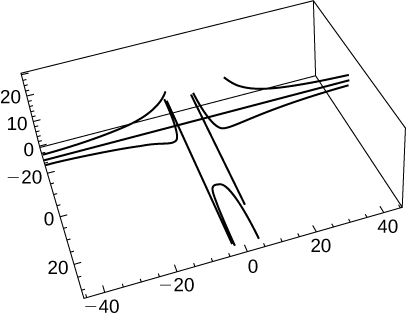
Find the velocity and the speed of a particle with the position function
The speed of a particle is the magnitude of the velocity and is represented by
A particle moves on a circular path of radius b according to the function
where
is the angular velocity,
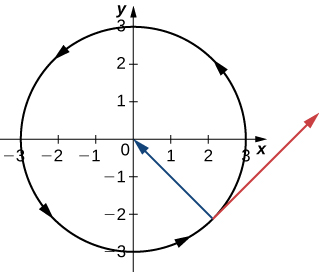
Find the velocity function and show that
is always orthogonal to
To show orthogonality, note that
Show that the speed of the particle is proportional to the angular velocity.
Evaluate
given
Find the antiderivative of
that satisfies the initial condition
Evaluate
An object starts from rest at point
and moves with an acceleration of
where
is measured in feet per second per second. Find the location of the object after
sec.
Show that if the speed of a particle traveling along a curve represented by a vector-valued function is constant, then the velocity function is always perpendicular to the acceleration function.
The last statement implies that the velocity and acceleration are perpendicular or orthogonal.* * *
Given
and
find
Given
find the velocity and the speed at any time.
Find the velocity vector for the function
Find the equation of the tangent line to the curve
at
Describe and sketch the curve represented by the vector-valued function
Locate the highest point on the curve
and give the value of the function at this point.
at
The position vector for a particle is
The graph is shown here:
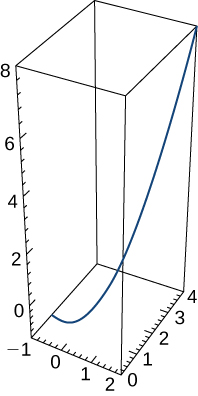
Find the velocity vector at any time.
Find the speed of the particle at time
sec.
Find the acceleration at time
sec.
A particle travels along the path of a helix with the equation
See the graph presented here:
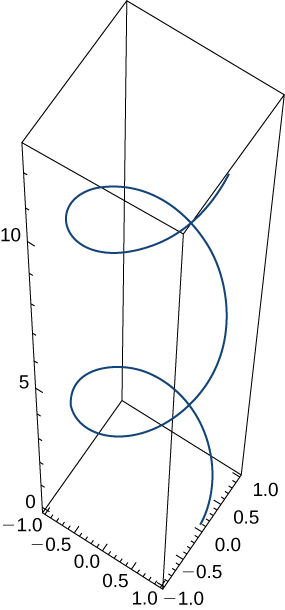 Find the following:
Find the following:
Velocity of the particle at any time
Speed of the particle at any time
Acceleration of the particle at any time
Find the unit tangent vector for the helix.
A particle travels along the path of an ellipse with the equation
Find the following:
Velocity of the particle
Speed of the particle at
Acceleration of the particle at
Given the vector-valued function
(graph is shown here), find the following:
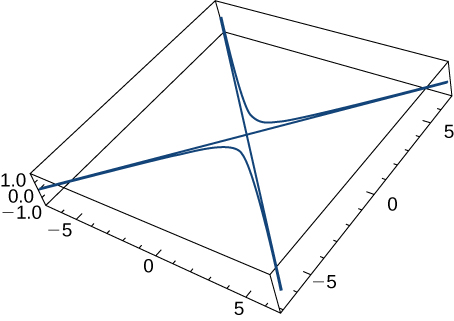
Velocity
Speed
Acceleration
Find the minimum speed of a particle traveling along the curve
2
Given
and
find the following:
Now, use the product rule for the derivative of the cross product of two vectors and show this result is the same as the answer for the preceding problem.
Find the unit tangent vector T(t) for the following vector-valued functions.
The graph is shown here:
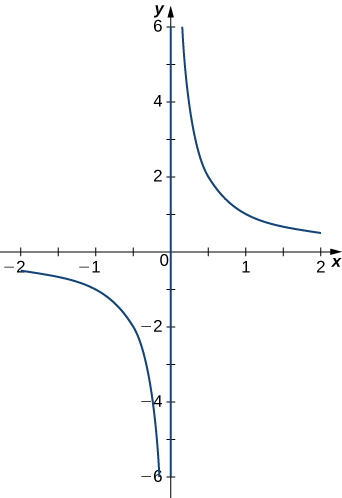
Evaluate the following integrals:
where
is
provided the limit exists
at
any vector v such that, when the tail of the vector is placed at point
on the graph, vector v is tangent to curve C

You can also download for free at http://cnx.org/contents/9a1df55a-b167-4736-b5ad-15d996704270@5.1
Attribution: